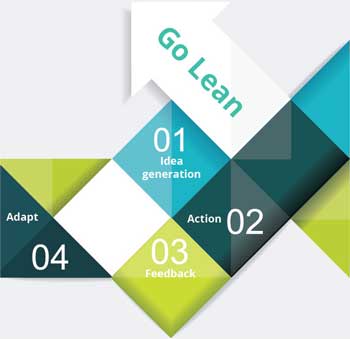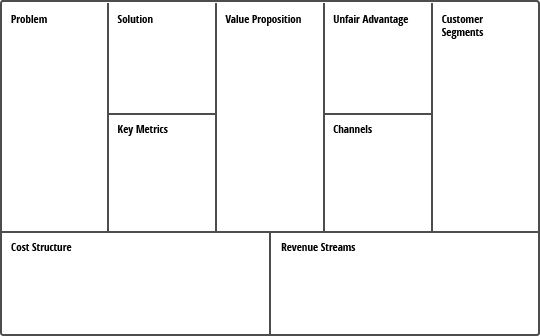Business Planning Revisited: Getting Lean Getting it Right
By Julie King | May 26, 2014
 "Business plans are the tool existing companies use for execution. They are the wrong tool to search for a business model." – Steve Blank
"Business plans are the tool existing companies use for execution. They are the wrong tool to search for a business model." – Steve Blank
CanadaOne won a national business plan competition in 1998, at which point the thick document was placed on a shelf, with a small summary document being used in our actual day-to-day activities.
The document was what bankers wanted – and in some cases still want – to see. The fundamental problem with the traditional business plan is that it is inherently static. The format is time consuming to update and assumes that the business model you develop is the right one.
Yet business today has changed significantly. We are communicating faster and more broadly. Our customers – and competitors – can now span the entire globe. The model for your entire business could be disrupted overnight.
What's App is a great example of this. The proprietary instant messaging service was able to disrupt the high cost of instant messaging services (SMS) in southeast Asia, by offering a data-based service that replicated SMS for $1 / year. Their user base grew from 250,000 in 2009 to 500 million active monthly users in April 2014.
In February 2014 Facebook announced that it would acquire What's App for $19 billion, making the 55 person company more valuable than many global multinationals, including several banks, Nintendo and the Sony Corporation.
Entrepreneurs and business owners need an approach that offers greater agility, so they can get to market faster and stay ahead of the competition. It's time to rethink the business plan.
Going Lean Business Model Canvas
Over the past six years several new approaches to business planning have been popularized, with newer tools often building on previous ones. Four of these are central to business planning:
- Business Model Canvas: Developed by Alexander Osterwalder, the business model canvas proposed a new planning methodology using a visual canvas that is suited to brainstorming and group contributions. The canvas approach also makes it easy to create iterations of your business model, as it is easy to updated the canvas in response to customer feedback.
- Lean Start-Up: The book by Eric Ries developed into a global movement, where start-ups develop a "minimum viable product" (MVP) and then go through a cycle of testing and adaptation ("pivots") to develop a final, customer-optimized product or service.
- The Fours Steps to Epiphany. This book, written by Steve Blank, introduced a Customer Development methodology designed to help businesses better understand their customers, and in doing so create products and services that customers will want.
- Lean Canvas: A modification of the Business Model Canvas developed by Ash Maurya, the Lean Canvas updated the business model canvas model to incorporate ideas central to the Lean Start-Up and Four Steps to Epiphany. It emphasizes the identification of problems, solutions and key metrics needed to measure the effectiveness of the business model. It also emphasizes the creation of "an unfair competitive advantage."
Using the Lean Canvas
For start-ups and smaller companies, I prefer the Lean Canvas approach, because it frames planning around very practical issues. (Click here to download a PDF version)

(The Lean Canvas was adapted from The Business Model Canvas (BusinessModelGeneration.com) by Ash Maurya and is licensed under the Creative Commons Attribution-Share Alike 3.0 Un-ported License.)
The canvas is designed to encourage brainstorming, with people jotting down notes and add them to the canvas. You may want to use post-it notes or a large whiteboard for initial planning and then as things become finalized you can transfer your plan to paper. There are also software tools that can help you complete the canvas.
Jane Gertner, an advisory with ventureLAB, a regional innovation centre based in Markham, ON, recommends approaching planning on the canvas in four segments:
- Problems, solutions & key metrics: The top left quadrant of the canvas is the best place to begin, as you map out your understanding of the reason your product is needed and how you will be able to measure these assumptions.
- Value proposition: Positioned in the centre of the canvas and possibly the most important part of the canvas, your value proposition puts your competitive advantage into words that are customer-focused.
- Unfair advantage, channels and customer segments: The top right quadrant of the canvas is where you will define who you are selling to, how you will reach those people and what you are doing that is different from your competition.
- Costs and revenue streams: In the bottom half of the canvas you will define the monetary aspects of your business. On the left you will identify what it will cost you to execute your plan and on the right you will define different revenue streams. Examples of common revenue streams include one-off product sales, recurring subscription revenues, licensing and franchising.
Steps to Putting the New Business Plan into Practice
The new approach to business planning is to focus on making it cyclic. You will create iterations of your plan as you gain a better understanding of your customers and want to keep the process side nimble and focused on the tasks of greatest importance.
The cycle works much like the scientific method:
- Make a hypothesis: What is your business model? In this first step, you capture your ideas about your business. What problems do your customers have and what product or service can you create to solve those problems? It is important to understand how your solution fits into the overall landscape.
- Develop a minimum viable product: Ries recommends that start-ups think big, but start small. While your vision may have you one day dominate your entire market, at this stage your goal is to get to market quickly with a product that people will buy, but does not yet have a full feature-set. At this stage you identify and build your MVP.
- Identify key metrics: As you develop your MVP, you need to understand how you are going to measure how well it matches customer needs. One of the most important key metrics is the customer's willingness to actually pay for your solution. Metrics should be specific and quantifiable.
- Launch & test: It is now time to launch your MVP and test its reception using the metrics you defined in the previous step. Your goal is to gather enough information to see trends. Steve Blank is a proponent of doing customers interviews and his Customer Development methodology is a great way to get feedback. It is important to approach customer surveys as market research and not sales, although if the people you survey like your offering they may decide to buy.
- Adapt your solutions: With your MVP launched, it is now time to learn from the information you have collected. Here you will gain an understanding of what you got right, things that you missed and problems with your original assumptions. Using feedback from customers, you will decide to continue development as planned, make small adjustments or do a more significant "pivot" and rethink fundamental parts of your business model. For example, there are many examples where businesses discover they are targeting the wrong customer set and need to rethink how to shift their offering to meet the needs of a different customer group.
- Repeat: Update your business model canvas and begin again, working through this same process using the learnings from your previous cycle.






